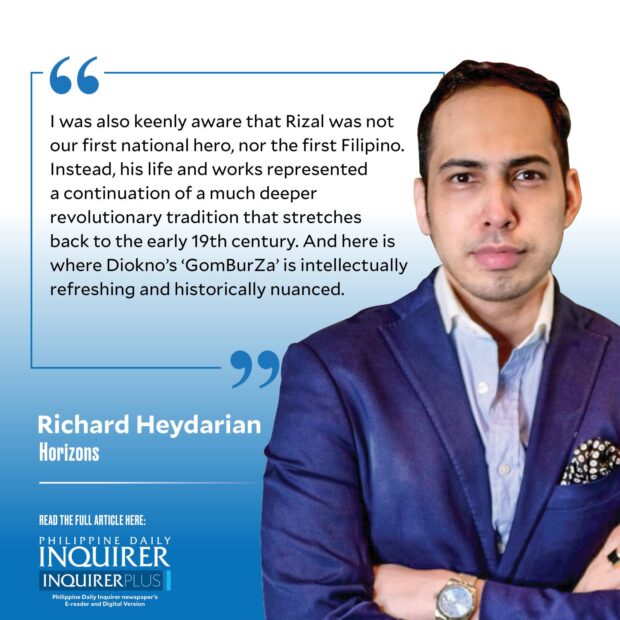A renaissance of Philippine cinema

Philippine cinema is back with a vengeance. A new generation of world-class directors is giving a much-needed boost to one of the fountains of our national culture. Think of Jhett Tolentino’s “Asian Persuasion,” which is arguably our answer to “Crazy Rich Asians.” Blessed with a dazzling cast, and led by no less than KC Concepcion, the movie is a beautiful tribute to the grittiness of the Filipino-American community and the broader vicissitudes of the Asian-American experience in the 21st century.
The script is elegant, the cast is judiciously selected, and the overall directorial footprint is magisterial. In many ways, Tolentino’s distinctly cosmopolitan yet authentically Filipino romantic-comedy movie may end up spawning a whole new genre for Philippine cinema—thus, boosting our chances to reclaim our place of pride among nations. And the historical movie landscape looks just as promising. Perhaps no Filipino director better symbolizes a new golden era of Philippine cinema than Jose Lorenzo “Pepe” Diokno III.
I first heard about the “GomBurZa” project while walking down the streets of Madrid. Just days earlier, I had witnessed the official induction of Rizal’s works into the canon of Spanish literature at Instituto Cervantes, So, quite naturally, I was haunted by the ghost of Rizal, and everything splendid that his intellectual legacy represented.
Article continues after this advertisementAnd yet, I was also keenly aware that Rizal was not our first national hero, nor the first Filipino. Instead, his life and works represented a continuation of a much deeper revolutionary tradition that stretches back to the early 19th century. And here is where Diokno’s “GomBurZa” is intellectually refreshing and historically nuanced.
The movie correctly recounts (spoiler alert!) the legacy of earlier generations of Filipino revolutionary such as Hermano Pule, a religious leader who defied institutionalized racism to establish the indigenous Cofradía de San José. His revolt came on the heels of Andrés Novales’ briefly successful coup against the Spanish regime in Manila.
This sets the tone for the opening scenes of the movie, where Padre Pedro Pelaez is subtly warning his protégé, Jose Burgos, against the vicissitudes of Spanish imperium. By the mid-19th century, the Spanish Empire was a shell of its former glory.
Article continues after this advertisementBarely half a century earlier, a priest, Miguel Hidalgo y Costilla, had successfully ejected Spain from Nueva España (Mexico). Not long after, another Spanish creole, Simón Bolívar, led a continent-wide set of revolutions in South America. Madrid was in no mood for compromise in the twilight decades of the 19th century. In fact, “GomBurZa” accurately captures the violent lashes of a dying beast, as the imperial machine began to nip any contrarian view in the bud.
One of the most telling scenes in “GomBurZa” is when Jose Burgos is confronted by the incorrigibility of the Spanish Empire. His call for basic “equality”—namely, between Philippine-born creoles and those born in Spain—was flatly rejected by the ostensibly sympathetic Governor General Carlos María de la Torre. This only served as a preview for the reactionary regime of Rafael Izquierdo, who deliberately pushed for maximum punishment for Mariano Gómes, José Burgos, and Jacinto Zamora.
The inane brutality of Zamora’s execution was masterfully portrayed by Enchong Dee, who seamlessly transitions from a playful youth into a most tragic figure. It was thanks to the intervention of the Catholic hierarchy that Izquierdo was forced to allow the three priests to retain their liturgical vestments at their moment of execution.
Thus, at once, Diokno’s movie transmits three crucial messages, namely (i) the first “Filipinos” were of extremely diverse ethnic and socioeconomic backgrounds; (ii) that Rizal’s generation of revolutionaries owed their political passions to much earlier generations, especially the martyrdom of the three priests; and (iii) that it was primarily the Spanish secular authorities—rather than the “friarocracy”—who were bent on a maximalist and ultimately violent approach to retain the Philippine Islands at any cost.
The final scenes of the movie are arguably the most powerful and emotionally wrenching. “I am innocent,” Jose Burgos protests in his final moments—with the sky above darkening and the crowd below drenched in sorrow—just to retreat into sublime submission when told by a presiding priest, “So was Jesus Christ.” And there lies the very spirit of sacrifice that birthed our tragic yet singularly beautiful nation.















